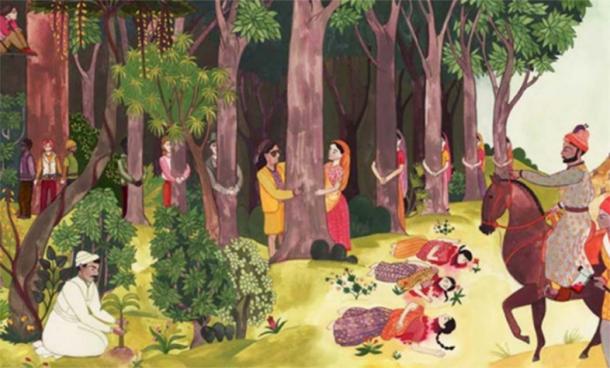
Tree-Hugging is Rooted in the Tragic Tale of the Khejarli Massacre
Throughout history there’s a multitude of examples of cruelty meted out by royalty, but the story of Abhai Singh of Marwar and the Khejarli massacre in India really stands out. In a David and Goliath story of shocking proportions, it seems that the 18th century maharaja had a group of tree-huggers murdered when they tried to stop him from chopping down sacred Khejri trees to build himself a palace.
The despotic maharaja of the Kingdom of Marwar, a northern Indian desert region in modern-day Rajasthan, Abhai Singh of Marwar ruled from 1724 to 1749. Coming to the throne after his father’s assassination, he reportedly imposed high taxes on his subjects to fund several costly wars. An arrogant and womanizing ruler, his reputation really took a tumble thanks to the Khejarli massacre of 1730.
Native to the Indian Subcontinent and parts of Western Asia, Khejri (a.k.a. Prosopis cineraria) are flowering trees seen as sacred among many Hindu groups in India. Found in arid regions such as Rajasthan, Khejri trees are well-suited to harsh drought conditions, providing farmers with shade and livestock with fodder during hot summer months. These trees are held in high esteem due to their association with Shiva, the god, who purportedly favored Khejri trees.

Sunset desert landscape with drought-resistant Khejri trees, which are sacred to the tree-hugging Bishnoi people. (eitazul / Adobe Stock)
The Bishnoi people, followers of the 15th-century guru Jambheshwar, have long upheld the values of environmental stewardship and coexistence with local ecosystems, particularly vital in the Marwar desert region. The Bishnois have historically held the Khejri tree in high esteem, recognizing its significance in their survival, and their beliefs forbid the harming of trees and animals.
The maharaja tasked his minister, Giridhar Bhandari, with collecting wood from the village of Khejarli, ostensibly for the construction of his palace. The Bishnois of the region were horrified upon witnessing the soldiers of the maharaja cutting down their beloved Khejri trees.

The first recorded case of tree-hugging took place during the Khejarli massacre in 1730, when the Bishnoi people defended their trees against the majaraja’s men. (Branch in the Works)
According to legend, Amrita Devi and her three daughters bravely hugged the trees to safeguard them from harm, only to be brutally attacked and beheaded by the soldiers. Upon hearing the news of the tree-huggers, successive waves of Bishnoi villagers resolved to defend their beloved trees with their lives - first the elders, followed by the young men, their wives, and finally, their children. In total, 363 Bishnois were killed.
After learning about the slaughter, the maharaja commanded his soldiers to stop, declaring the Bishnoi state a protected region for both trees and animals. Despite the term "tree-hugging" being used to mock environmentalists today, the Khejarli massacre is the earliest documented example of tree-hugging as an act of environmental activism. Since 2013, September 11th is an annual commemoration of the Khejarli massacre known as National Forest Martyrs Day.
Top image: Tree-hugging has its ancient roots in environmental activism. Source: warnerbroers / Adobe Stock















